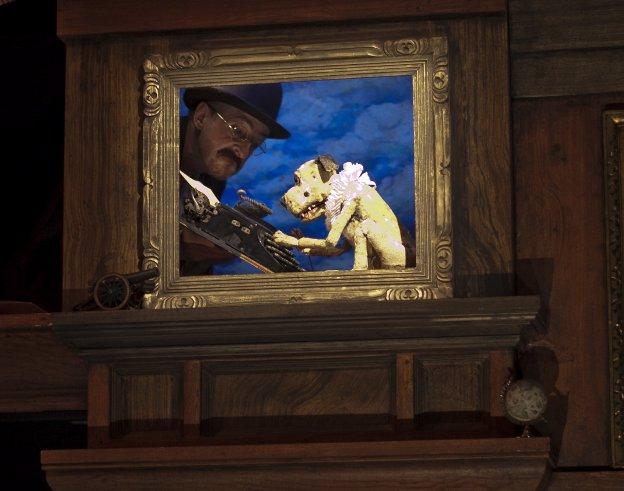Improbable’s new show, led in this case by director / designer Julian Crouch, is a strange and stirring affair. The opening moments are near perfection, for me. In a gilt frame, against a blue sky, a single, gloveless hand presents itself: the puppet unmasked. Through another small panel, a hand reaches out and sets a chiming metronome running. Later we learn that its rhythm is set to mirror the incidence of murder globally (every 1.36 seconds, apparently) as a sop against Punch’s heinous crimes, but for now it simply enhances the sense of claustrophobia and the fragile orderliness of the scene. The images are charged and resonant.
In Crouch’s production, commissioned to mark the 350th Anniversary of Punch’s ‘birth’ in England (in fact his first recorded reference here – in Samuel Pepys diary), the anarchic energies of Punch are recast within a panelled parlour, against which contrast his potency strains effectively. The set, designed by Crouch with Mike Kerns and Rob Thirtle (who also performs), is a bold and impassive wall of wood, its rich tones opening into a series of frames where classic Punch sketches are brought back to life. These modernisations work particularly well, subtly contemporising the well-known material – Punch and the crocodile, the hanging scene, the courtroom – to give them an immediacy in tone and language that brings them closer to us.
Ironically, perhaps, the actual frame felt thinner. Crouch’s research had unearthed touring American nineteenth-century Punch performers Harvey and Hovey, who were presumably a gift for bridging the diverging imperatives of a cross-Atlantic commissioning team (the Barbican, Philadelphia Live Arts Festival, and the Minneapolis’ Walker Art Center). The deteriorating relationship between these two clowns (brilliantly conveyed by Rob Thirtle and Nick Haverson, all mustachioed grandeur, histrionics and some rather good voice throwing) and between them and their audience conveyed something of the pathos of the end of the music hall age. Who the other performer / musicians were supposed to be, or how they fit into the frame of Harvey and Hovey’s travelling puppet show never became clear and some of the music, particularly the folksy American duets that bookended the show, felt woefully unintegrated and unjustified.
This was, it became clear, fundamentally a show about theatre-making, its object the demise of the itinerant player and with audience expectations themselves in the dock. This felt clever, and somewhat unearned. Punch has always been a crowd pleaser; with more in common with commedia street performances than dramatic narrative, he embodies a spirit more than a story and so feels ill-suited to carry meta-theatrical angst. Perhaps what was being recast was Crouch’s own anxiety about the production’s reception, which feels a shame, as the show’s finest moments were those with least self-consciousness. This was also, though, a show about puppetry, populated by Sicilian fighting marionettes, live sound effects, dancing pigs (turned into sausages, naturally), humanettes, masks and an army of beautifully disembodied hands. As a tiny glove punch reaches out to silence the ever-ticking metronome and both human performers lie dead, I can’t help but feel that this show really captures some of the strange power and ritual of Punch, which transcends even the most dramatic or intellectual of attempts to contain him.


